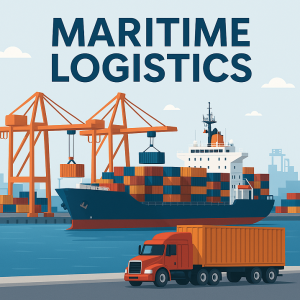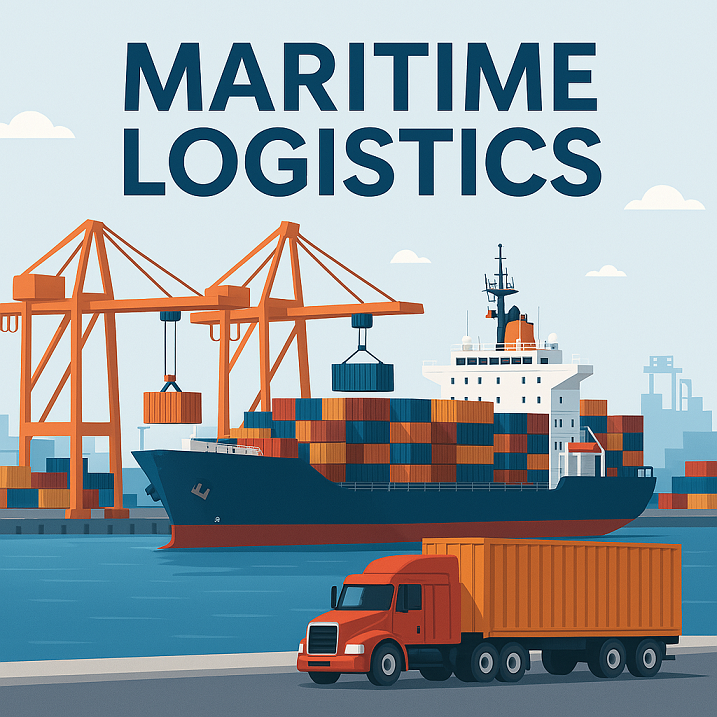Explore the world of maritime logistics—its definition, importance, processes, challenges, and future trends. A must-read guide for maritime students, cadets, ship officers, shipping companies, and industry professionals.
How Do Goods Move Seamlessly Across the Seas?
When you buy a smartphone made in China, coffee from Brazil, or a car from Germany—how do these goods arrive in your country? The answer lies in the complex, powerful, and precise system of maritime logistics. It ensures that global supply chains function smoothly across oceans, continents, and ports.
For maritime students, cadets, ship officers, and logistics professionals, understanding maritime logistics is key to navigating today’s globalized economy. This comprehensive, SEO-optimized article covers all you need to know about maritime logistics—from fundamental concepts to real-world applications and future trends.

What Is Maritime Logistics?
Maritime logistics refers to the planning, coordination, and management of cargo transportation by sea, involving the movement of goods from origin to destination using ships, ports, and intermodal connections.
🧭 Key Functions:
-
Cargo planning and handling
-
Vessel scheduling and routing
-
Port operations and terminal management
-
Customs clearance and regulatory compliance
-
Integration with land/air transportation systems
🚢 It is a subset of supply chain management focused on optimizing the sea leg of freight transport.
Importance of Maritime Logistics in Global Trade
-
Over 80% of global trade by volume and 70% by value is carried by sea.
-
Critical to sectors like retail, automotive, energy, and agriculture.
-
Enables cost-effective, large-volume shipping across long distances.
-
Supports global economic interdependence and consumer accessibility.
Key Components of Maritime Logistics
⚓ 1. Shipping Lines and Cargo Vessels
-
Liner shipping (fixed schedules) vs. tramp shipping (irregular schedules)
-
Container ships, bulk carriers, tankers, Ro-Ro vessels
-
Top companies: Maersk, MSC, CMA CGM, COSCO, Hapag-Lloyd
🏗️ 2. Port Operations and Terminal Logistics
-
Port entry and berth allocation
-
Loading/unloading via cranes, forklifts, and conveyor systems
-
Storage, container stacking, and reefer management
-
Port community systems and smart port tech
📦 3. Intermodal Transport and Last-Mile Delivery
-
Movement of cargo between ships, trucks, and trains
-
Use of intermodal containers for seamless transfers
-
Ensures cargo reaches inland destinations from seaports
🗂️ 4. Documentation and Regulatory Compliance
-
Bill of Lading, Packing List, Commercial Invoice
-
Customs declarations and port clearance procedures
-
SOLAS VGM (Verified Gross Mass) requirements
💡 5. Technology in Maritime Logistics
-
GPS & AIS tracking of vessels
-
Warehouse Management Systems (WMS)
-
Blockchain for transparent transactions
-
Artificial Intelligence for predictive logistics
Real-World Applications and Examples
🔹 Example 1: The Just-in-Time Shipping Model
Used in industries like automotive manufacturing, where parts must arrive exactly when needed. Delays at sea can halt production lines.
🔹 Example 2: Cold Chain Logistics
Reefer containers are used to transport perishable goods like pharmaceuticals, seafood, and fruits. Logistics teams ensure uninterrupted cold storage.
🔹 Example 3: Port of Rotterdam’s Digital Twin
The port uses real-time data, sensors, and predictive modeling to optimize cargo flow and reduce waiting times.
Latest Trends and Future Outlook
🌱 1. Green and Sustainable Logistics
-
Emphasis on reducing GHG emissions, slow steaming, and fuel alternatives
-
Integration of energy-efficient port infrastructure and hybrid vessels
📲 2. Smart Ports and Automation
-
IoT-enabled cranes, autonomous vehicles, and port digital twins
-
Improves turnaround time and cargo visibility
🤖 3. Artificial Intelligence and Predictive Analytics
-
AI to optimize routes, manage congestion, and reduce fuel consumption
-
Digital freight forwarding platforms using machine learning
🌍 4. Resilient Supply Chains Post-Pandemic
-
Shift from lean to resilient logistics models
-
Greater use of regional hubs and nearshoring
Career Opportunities in Maritime Logistics
🚀 In-Demand Roles:
-
Port and Terminal Manager
-
Shipping Operations Coordinator
-
Maritime Logistics Analyst
-
Customs Broker
-
Supply Chain Planner
-
Freight Forwarder
-
Vessel Scheduler
🎓 Required Skills & Qualifications:
-
Knowledge of INCOTERMS, IMDG Code, and maritime regulations
-
Proficiency in logistics software and analytics tools
-
Degrees in Maritime Logistics, Supply Chain, or Marine Engineering
💼 Tip: Explore internship programs with port authorities, shipping lines, or logistics companies to gain practical experience.
FAQs: People Also Ask
What is maritime logistics in simple terms?
It is the process of managing the movement of goods across the sea, from loading cargo onto ships to ensuring it reaches its final inland destination efficiently and safely.
How is maritime logistics different from regular logistics?
Maritime logistics specifically focuses on sea transport and port operations, whereas regular logistics may involve land, rail, or air transport.
What is the role of a freight forwarder in maritime logistics?
A freight forwarder arranges the transportation of cargo by sea, manages documentation, and ensures timely customs clearance and delivery.
Are there jobs in maritime logistics?
Yes, careers range from vessel operations to port management and global supply chain coordination, with strong demand for skilled professionals.
Conclusion: Maritime Logistics—The Lifeline of Global Trade
In a world where products are expected to arrive faster, cheaper, and more sustainably, maritime logistics plays a pivotal role. From students preparing for cadetship to ship operators and industry strategists, everyone benefits from a deep understanding of this complex yet fascinating field.
⚓ Next Steps:
-
Download Maritime Logistics Glossary PDF

